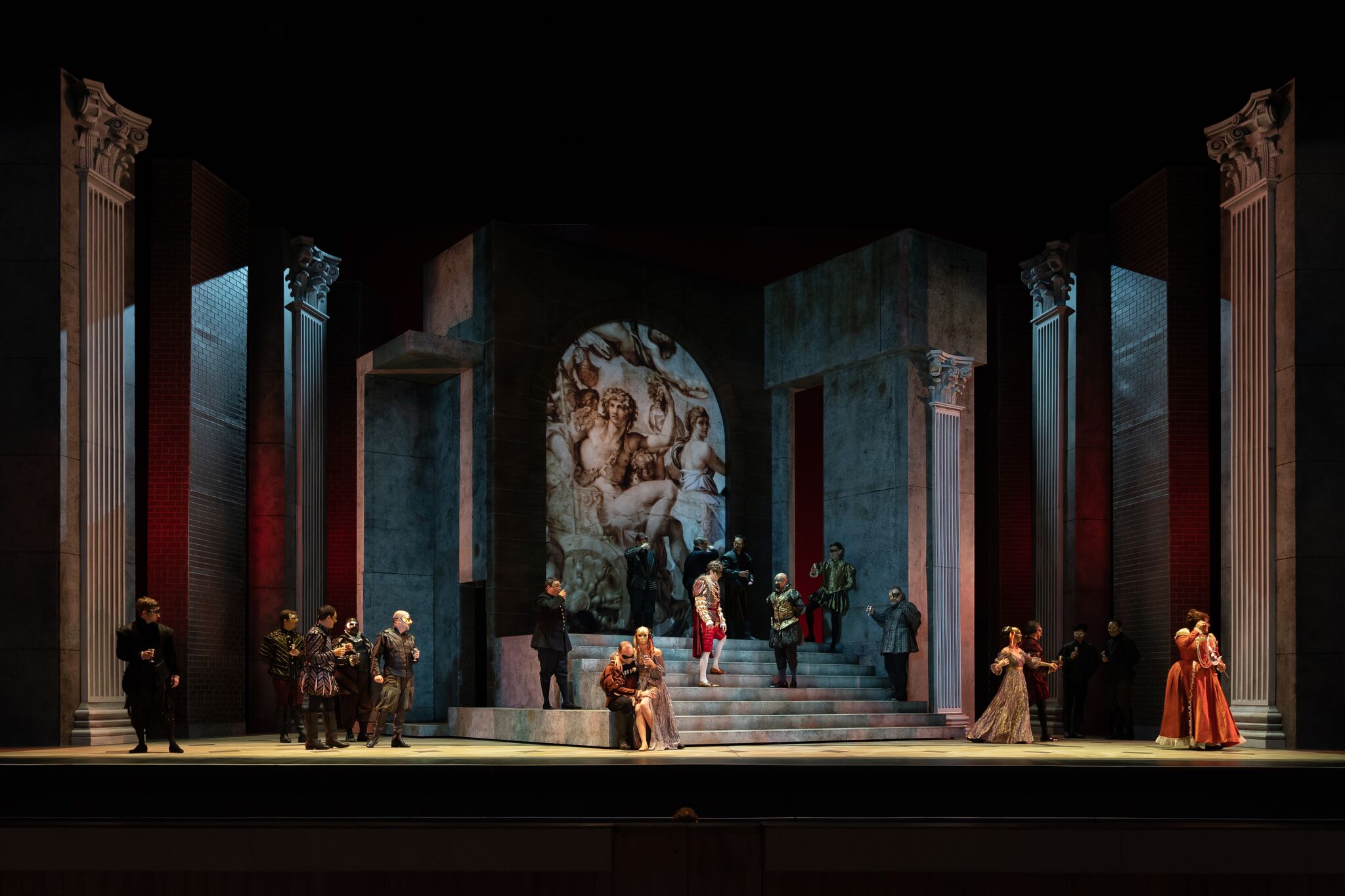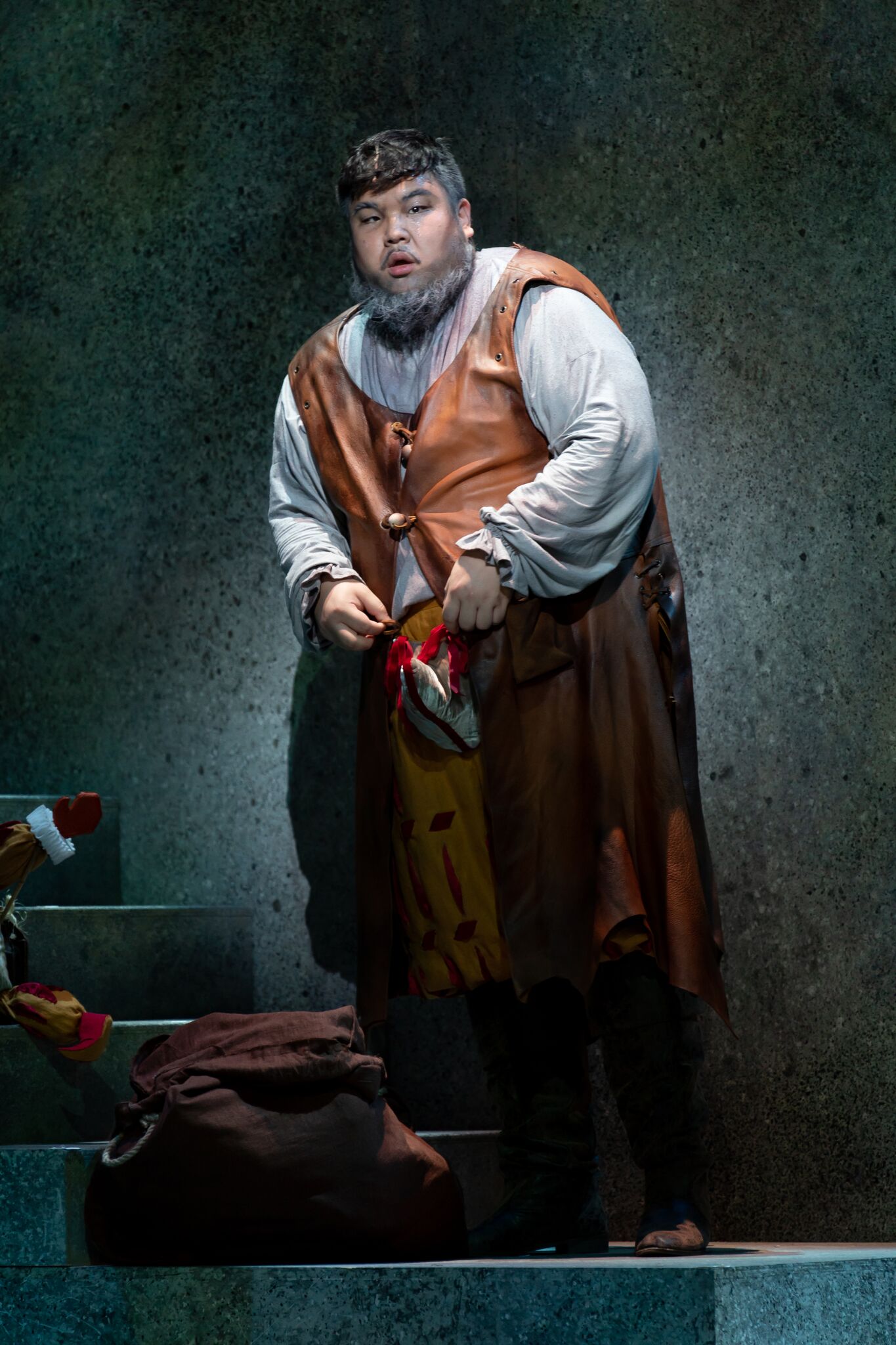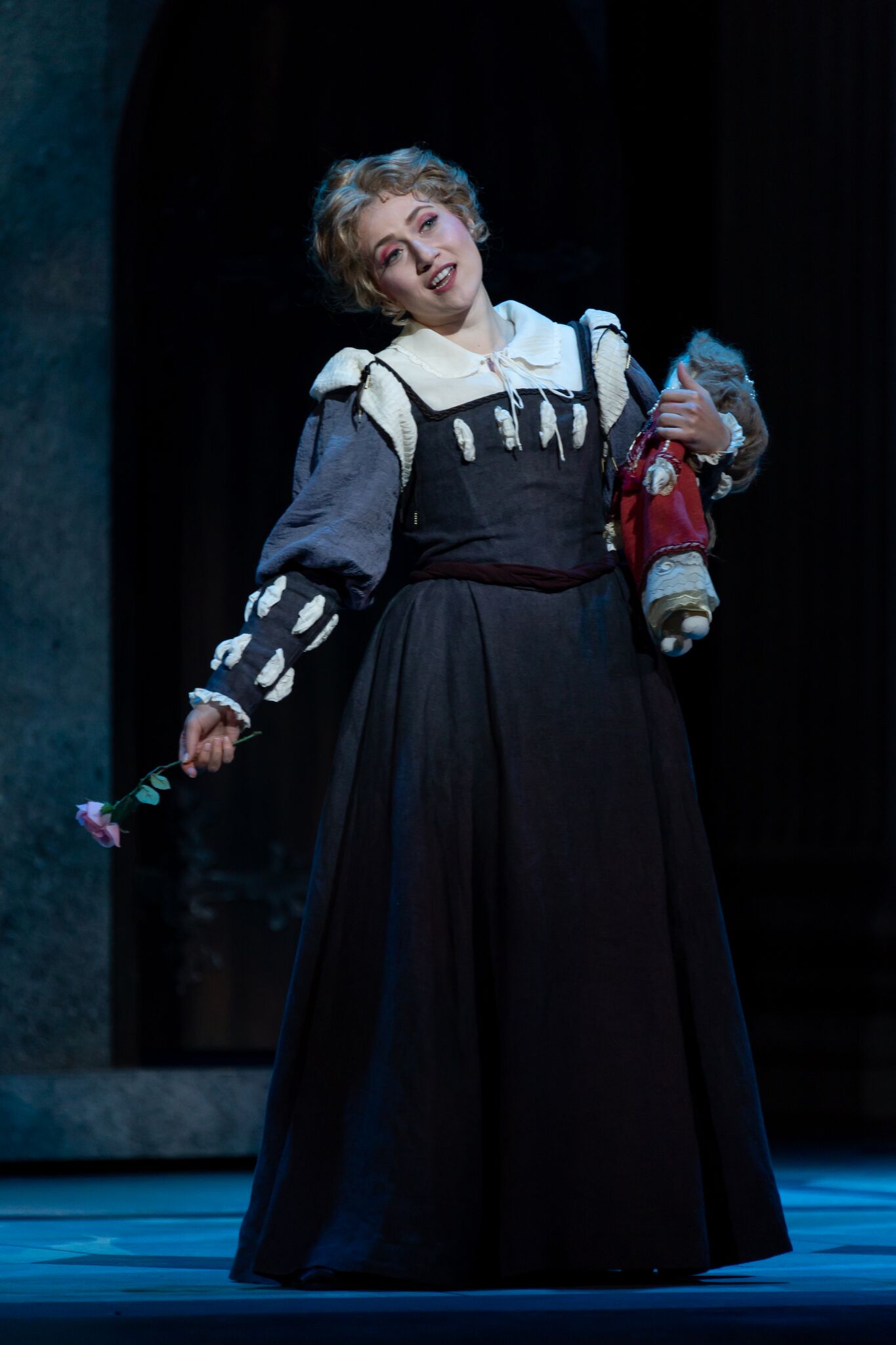It’s a shame that Wolf Trap Opera’s production of Giuseppe Verdi’s Rigoletto (1851) on Friday night was just for one performance. They had to provide a credible performance of a Verdi favorite while contending with the venue’s challenges for presenting opera in an amphitheater (open walls, outside noise, and necessity to use singer microphones in a large venue). WTO managed to contend with all these elements, yielding a triumph for the company and a fine grand opera for its community. I can only quibble that the weather which provided rain throughout the evening, harassing those in the lawn seats, failed to provide atmospheric thunder and lightning for final act. Again, Wolf Trap’s Filene Center drew in a much younger crowd than I see at the major opera houses, many likely there for their first opera. When I first fell in love with opera, for a long time Rigoletto was my favorite. It likely made some new fans Friday night.
Opening set and cast for Rigoletto. Photo by Scott Suchman; courtesy of Wolf Trap Opera.
The tale of Rigoletto is a painful story to watch. Librettist Francesco Maria Piave wove a complex story with complex characters based on a play by Victor Hugo which forces us to watch as power-enabled licentiousness pummels tenderness and innocence and our own hearts, a story all the more relevant as we have seen example after example exposed in today’s headlines. Rigoletto is a court jester, but he’s not funny; his main job is to cajole husbands and fathers in the court to draw attention and wrath away from his boss, the Duke of Mantua, who is seducing and raping their wives and daughters. Rigoletto, whose outward life has been deformed by his treatment as a hunchback, has a passionate and loving inside, and a young daughter, Gilda, who he keeps hidden away and who knows little of the outside world. Rigoletto's taunts to one father, Count Monterone, who has confronted the Duke about his daughter elicits a curse from the Count that instills fear in Rigoletto and sets the tragedy in motion. Verdi originally titled the opera "La Maledizione" or "The Curse". The angered courtiers learn of a young woman in Rigoletto’s life; thinking her his mistress, they steal her away to the Duke's room. The Duke has previously encountered Gilda in church, the only other place than home she was allowed to go and won her affection. He trails her home and presents himself as a poor student to further seal her infatuation with him. When the courtiers leave her in the Duke’s room he realizes it is Gilda and forces himself upon his naive and vulnerable victim. Rigoletto, turned vengeful, leads Gilda to see the Duke with another woman, Maddelena, and plots the Duke’s murder by a paid assassin, Sparafucile, who is Maddelena’s brother; however, Gilda still loves the Duke and pleads for his life, even to the point of ultimately sacrificing herself for her loved one. The Duke who earlier sang that Gilda’s beauty and innocence were almost enough to cause him to lead a moral life goes unpunished for his deeds.
Kidon Choi as Rigoletto in his jester role and as a worried father outside his home. Photos by Scott Suchman; courtesy of Wolf Trap Opera.
The staging of this production was quite effective. The set which might have been standard at the Metropolitan Opera, was nothing short of stunning at the Filene Center. The opening oversized towering columns shadowed in colored light on either side of an entrance foyer adorned with an outsized Roman painting (media/light provided) and with steps flowing down to a large ballroom clearly spoke of power and authority. For the different acts, a circular center stage rotated to provide for an outside view of Rigoletto and Gilda’s domicile and then again to show Maddalena and Sparafucile’s low life tavern. The gorgeous 16th century costumes were displayed early as two statuesque courtesans masked in silver (or maybe gold, I forget) entered and descended the stairs as courtiers filled the ballroom. The Duke makes an entrance singing why tell me to hush; the husbands can’t do anything to me; and he is told, yes, but the women might learn you are with another woman. You are immediately drawn into the action and it proceeds without letup through the entire evening. The placement and movement of the players worked very well. There were two inventions for this production that for me, worked for and against the story. The ventriloquist dummy carried by Rigoletto foretold he was a jester though he was not otherwise funny, and it occasionally accented the emotion, but sometimes was a distraction. Same for the media and lighting effects which added a modern feel to the production that I liked and in at least one scene helped convey the turmoil, but the images and the effects were interesting separate from the story and thereby sometimes detracted from the emotional impact of the scene. The staging of the final scene was novel with the singing-Gilda on a balcony overhead while Rigoletto anguishes over the expiring-Gilda in his arms; that choice gives the impression that our true-hearted one is going to heaven, but perhaps detracts slightly from our grief over her death. Either way works, but it’s likely much easier for the soprano to sing and project outward standing up. Overall, the team told the story well: Kudos to Director Crystal Mannich, Scenic Designer Erhard Rom, Video & Projections Designer S. Katy Tucker, Costume Designer Court Watson, Lighting Designer Mark Stanley, and Wig & Makeup Designer Anne Nesmith.
Piotr Buszewski as the Duke and Mané Galoyan as Gilda. Photos by Scott Suchman; courtesy of Wolf Trap Opera.
Mainly, it’s the music and singing in Rigoletto that must carry the evening. Musicologists say that Rigoletto begins a new period in Verdi's development, separating from the Italian "ottocentro" form of opera and initiating Verdi's "march to greatness". There is very little recitative as the music is integral to telling of the story; and best for me, there are lots of great melodies. You will likely be singing "Donna e mobile" after a performance, or "Caro Nome" if you are a coloratura soprano; audio recordings of Rigoletto are among my favorites. So, let’s talk about the band, also in this case called the National Symphony Orchestra, which was conducted by Grant Gershon, Resident Conductor of the Los Angeles Opera. I was glad to see them placed in the pit this time and not behind a set affecting the sound. I thought they played well, coordinating with the singers well, and contributing to the emotion and the storytelling. Kudos for that. However, from where I was sitting they seemed a wee bit muted compared to the highly amplified singers. Only conscientious of it a couple of times and I loved the music. I also enjoyed the chorus, a major player, in this opera. Kudos to Chorusmaster David Hanlon.
Patrick Guetti as Sparafucile and Zoie Reams as Maddalena as she pleads for the Duke's life. Photos by Scott Suchman; courtesy of Wolf Trap Opera.
As always, the highlight of any Wolf Trap Opera is the young singers here to participate in the summer Filene Artists training program. The principal singers, baritone Kidon Choi as Rigoletto, tenor Piotr Buszewski as the Duke, and soprano Mané Galoyan as Gilda sang beautifully. It is difficult to say much about their power since they were mic’d, but all seemed excellent choices for their roles. Mr. Choi’s baritone voice is impressive. I thought his acting was good, but perhaps too youthful to fully convey the depth of feeling in Rigoletto. Mr. Buszewski has a lovely tenor voice and played the handsome, arrogant, and charming Duke convincingly. Ms. Galoyan was a stand out as Gilda; her expressive voice and acting fully conveyed the pathos of the innocent, love-stricken 16 year-old daughter. Her “Caro Nome” was nuanced and lovely. Often in operas, some of the singers in minor roles make themselves noticed. For me, that role was taken by Patrick Guetti as Sparafucile; from his first scene he embodied the sinister, scary assassin reinforced by his strong, dark bass voice. Zoie Reams who played his sister Maddlena gave another fine WTO performance. Joshua Conyers was also notable as a distraught and angered Count Monterone. The duets and ensemble arias by this cast were especially well done and enjoyable, including the famous quartet aria near the end between Maddalena, Sparafucile, Gilda, and Rigoletto. The supporting cast all played their roles well.
Johnathan McCullough as Marullo, Joshua Conyers as Count Monterone, and Nicholas Nestorak as Matteo Borsa, as the two courtiers restrain the enraged Count. Photos by Scott Suchman; courtesy of Wolf Trap Opera.
WTO has clearly moved into the big time, not only in their principal role of training the next generation of opera singers, but also in providing marvelous opera productions and events to it's greater DC community. I am glad that the Wolf Trap Foundation provides them the opportunity once a year to show a wider audience what opera can offer. Congrats to Wolf Trap Opera for an outstanding summer season lighting up the Filene Center, the Barns, and various venues around town, and I look forward to the coming year, again.
The Fan Experience: If you saw this performance as your first opera and liked it, give the Barns a try next season; it is enclosed, but it is just about as informal as the Filene Center; it has easy access and egress, and the acoustics are better for opera. The Filene Center has large overhead screens to the left and right of the stage that showed a closer view of the singers during the performance, which I liked, but were also annoying because when I was watching the stage they provide considerable background glare. At the Barns you will be close enough you don’t need them. Also, you don’t have to wait for next summer to try opera again. The DC area is blessed with many excellent companies. As one example, Washington National Opera will be performing La Traviata at the Kennedy Center October 6-21; enjoy another round of great music by Verdi, also with with lots of great melodies.







